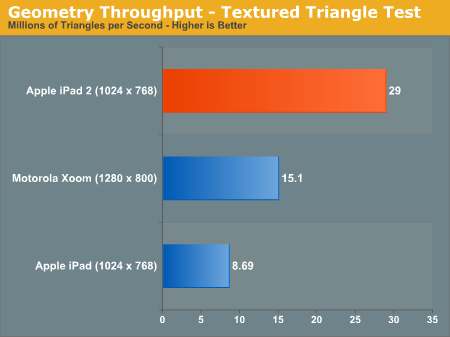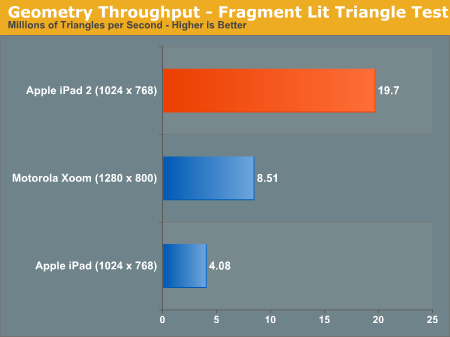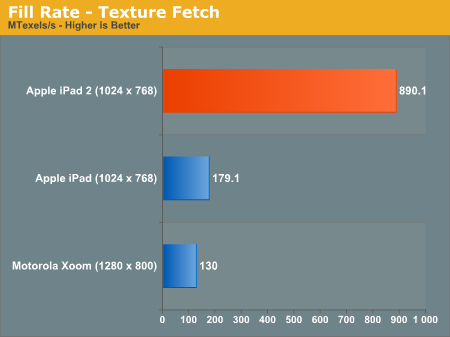Apple iPad 2 GPU Performance Explored: PowerVR SGX543MP2 Benchmarked
by Anand Lal Shimpi on March 12, 2011 3:04 PM EST- Posted in
- Smartphones
- Apple
- iPad
- GLBenchmark
- iPad 2
- Mobile
- Tablets
Earlier this morning we published our first impressions on Apple's iPad 2, including analysis on camera quality and a dive into the architecture behind Apple's A5 SoC. Our SoC investigation mostly focused on CPU performance, which we found to be a healthy 50% faster than the A4 in the original iPad - at least in web browsing. We were able to exceed Apple's claim of up to 2x performance increase in some synthetic tests, but even a 50% increase in javascript and web page loading performance isn't anything to be upset about. We briefly touched on the GPU: Imagination Technologies' PowerVR SGX 543MP2. Here Apple is promising up to a 9x increase in performance, but it's something we wanted to investigate.
Architecturally the 543MP2 has more than twice the compute horsepower of the SGX 535 used in Apple's A4. Each shader pipeline can execute twice the number of instructions per clock as the SGX 535, and then there are four times as many pipes in an SGX 543MP2 as there are in a 535. There are also efficiency improvements as well. Hidden surface removal works at twice the rate in the 543MP2 as it did in the 535. There's also a big boost in texture filtering performance as you'll see below.
As always we turn to GLBenchmark 2.0, a benchmark crafted by a bunch of developers who either have or had experience doing development work for some of the big dev houses in the industry. We'll start with some of the synthetics.
Over the course of PC gaming evolution we noticed a significant increase in geometry complexity. We'll likely see a similar evolution with games in the ultra mobile space, and as a result this next round of ultra mobile GPUs will seriously ramp up geometry performance.
Here we look at two different geometry tests amounting to the (almost) best and worst case triangle throughput measured by GLBenchmark 2.0. First we have the best case scenario - a textured triangle:

The original iPad could manage 8.7 million triangles per second in this test. The iPad 2? 29 million. An increase of over 3x. Developers with existing titles on the iPad could conceivably triple geometry complexity with no impact on performance on the iPad 2.
Now for the more complex case - a fragment lit triangle test:

The performance gap widens. While the PowerVR SGX 535 in the A4 could barely break 4 million triangles per second in this test, the PowerVR SGX 543MP2 in the A5 manages just under 20 million. There's just no competition here.
I mentioned an improvement in texturing performance earlier. The GLBenchmark texture fetch test puts numbers to that statement:

We're talking about nearly a 5x increase in texture fetch performance. This has to be due to more than an increase in the amount of texturing hardware. An improvement in throughput? Increase in memory bandwidth? It's tough to say without knowing more at this point.
| Apple iPad vs. iPad 2 | ||||
| Apple iPad (PowerVR SGX 535) | Apple iPad 2 (PowerVR SGX 543MP2) | |||
| Array test - uniform array access |
3412.4 kVertex/s
|
3864.0 kVertex/s
|
||
| Branching test - balanced |
2002.2 kShaders/s
|
11412.4 kShaders/s
|
||
| Branching test - fragment weighted |
5784.3 kFragments/s
|
22402.6kFragments/s
|
||
| Branching test - vertex weighted |
3905.9 kVertex/s
|
3870.6 kVertex/s
|
||
| Common test - balanced |
1025.3 kShaders/s
|
4092.5 kShaders/s
|
||
| Common test - fragment weighted |
1603.7 kFragments/s
|
3708.2 kFragments/s
|
||
| Common test - vertex weighted |
1516.6 kVertex/s
|
3714.0 kVertex/s
|
||
| Geometric test - balanced |
1276.2 kShaders/s
|
6238.4 kShaders/s
|
||
| Geometric test - fragment weighted |
2000.6 kFragments/s
|
6382.0 kFragments/s
|
||
| Geometric test - vertex weighted |
1921.5 kVertex/s
|
3780.9 kVertex/s
|
||
| Exponential test - balanced |
2013.2 kShaders/s
|
11758.0 kShaders/s
|
||
| Exponential test - fragment weighted |
3632.3 kFragments/s
|
11151.8 kFragments/s
|
||
| Exponential test - vertex weighted |
3118.1 kVertex/s
|
3634.1 kVertex/s
|
||
| Fill test - texture fetch |
179116.2 kTexels/s
|
890077.6 kTexels/s
|
||
| For loop test - balanced |
1295.1 kShaders/s
|
3719.1 kShaders/s
|
||
| For loop test - fragment weighted |
1777.3 kFragments/s
|
6182.8 kFragments/s
|
||
| For loop test - vertex weighted |
1418.3 kVertex/s
|
3813.5 kVertex/s
|
||
| Triangle test - textured |
8691.5 kTriangles/s
|
29019.9 kTriangles/s
|
||
| Triangle test - textured, fragment lit |
4084.9 kTriangles/s
|
19695.8 kTriangles/s
|
||
| Triangle test - textured, vertex lit |
6912.4 kTriangles/s
|
20907.1 kTriangles/s
|
||
| Triangle test - white |
9621.7 kTriangles/s
|
29771.1 kTriangles/s
|
||
| Trigonometric test - balanced |
1292.6 kShaders/s
|
3249.9 kShaders/s
|
||
| Trigonometric test - fragment weighted |
1103.9 kFragments/s
|
3502.5 kFragments/s
|
||
| Trigonometric test - vertex weighted |
1018.8 kVertex/s
|
3091.7 kVertex/s
|
||
| Swapbuffer Speed |
600
|
599
|
||
Enough with the synthetics - how much of an improvement does all of this yield in the actual GLBenchmark 2.0 game tests? Oh it's big.











219 Comments
View All Comments
rish95 - Sunday, March 13, 2011 - link
This is wrong. The SGX543MP2 has 16 4-way ALUs. A single SGX 543 has 8 4-way ALUs. So make that 38.4 GFLOPS.somata - Sunday, March 13, 2011 - link
Where did you get that info? I'll admit I based my initial knowledge of the SGX543 on what I gleaned from the informed discussion on the Beyond3D forums along with Wikipedia. Any publicly avaialable info from Imagination Technologies seems to only be available in press releases, which don't go into too much detail. I did find this, however, which officially disputes your 16 ALUs claim:http://www.imgtec.com/News/Release/index.asp?NewsI...
"[...]Taking the already high-performance four-pipe POWERVR SGX543, and then scaling that performance up to between eight and 64 pipelines[...]"
After further reading, it appears that SGX535 actually contains just 2, 32-bit-wide shaders (4-way int8, 2-way in16, and just one fp32 ALU per pipe), based on this (GMA 500 uses PowerVR SGX535):
http://download.intel.com/design/chipsets/embedded...
The SGX543 doubles the number of shaders and improves on their capabilities (looks like 2-way fp32 ALUs based on "2x floating point" mentioned in the above PR), but I can't find any credible sources that explicitly discuss the exact changes. So it looks like my calculations may actually have been too high by a factor of two.
Juzcallmeneo - Sunday, March 13, 2011 - link
isn't that the GPU in the next PSP?tipoo - Sunday, March 13, 2011 - link
NGP = the next PSP, and yes, it will use the MP4B3an - Saturday, March 12, 2011 - link
"We've got no less than four units running through battery life tests right now"...You hardly ever do anything like this for other hardware.
And you already have two preview articles for this Apple junk in one day. Very obvious the favouritism here. You -even- seem to often spend more time taking better photo's of Apples products for your articles than you do with other products.
I'd ask if Apple was paying you or giving you free gear, like they have done with reviewers before, but i dont think Anand would atleast stoop that low.
rish95 - Saturday, March 12, 2011 - link
Maybe because Apple products are so hyped and popular? It's a known fact that the iPad 2 will outsell the Xoom by a huge margin, and more people would like to know about it.And clearly these benchamrks prove this isn't junk. It proves the Tegra 2 is junk.
ncb1010 - Saturday, March 12, 2011 - link
Well, the Tegra 2 actually beats the A5 in CPU tests. So it comes down to this:CPU or GPU...which do you prefer?
DeathChill - Saturday, March 12, 2011 - link
Just curious, where did you get this information? I haven't seen anything so I'm interested.rish95 - Saturday, March 12, 2011 - link
No it didn't? Both have dual core Cortex A9s clocked at 1 GHz with 1MB L2 cache. And if it did beat the iPad, it was probably Apple's strict as hell throttling system causing it.DigitalFreak - Saturday, March 12, 2011 - link
Go away little fanboy. The adults are having a conversation.